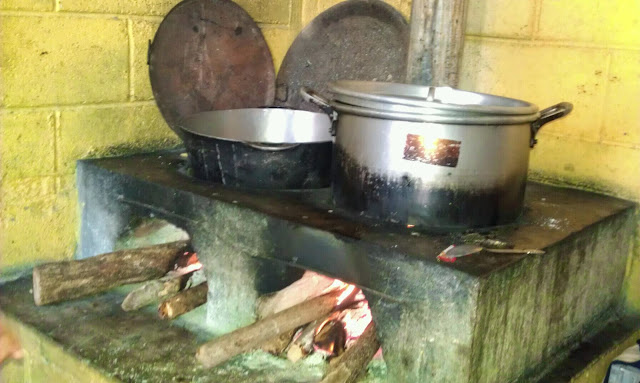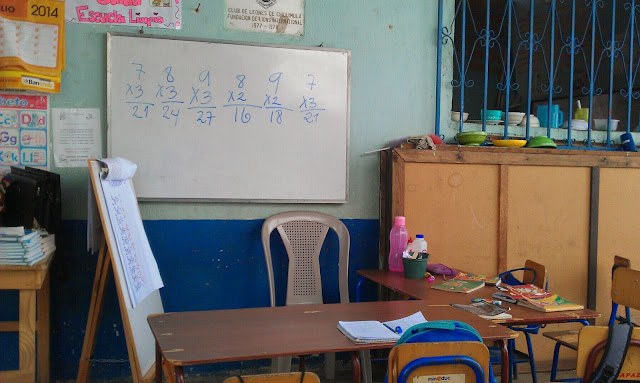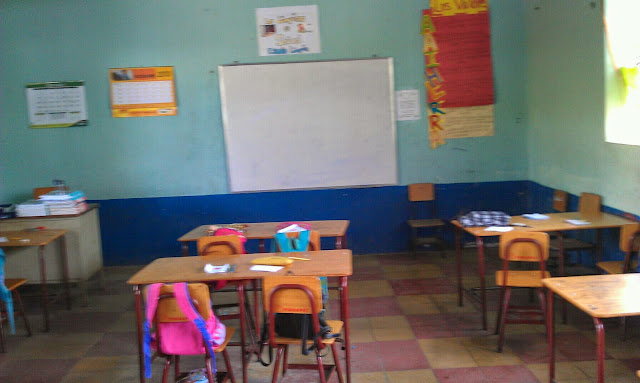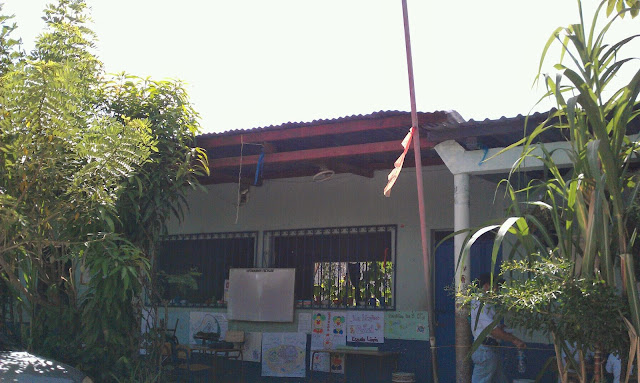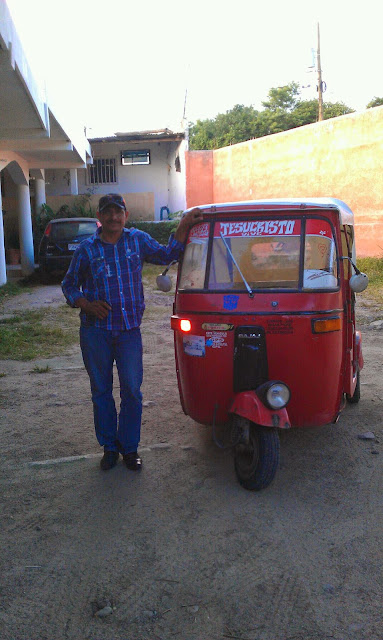- Be grateful for what you have: The air conditioner in my classroom broke right before the beginning of this past school year. Since one of the reasons I agreed to move to the South was because of the pictures of the shiny air conditioners in the district's recruitment literature, I immediately made it my mission to have this problem corrected as soon as possible. As word spread, I received over a dozen visits from colleagues who not only dropped off fans, but reassured me that our working conditions are "terrible". Of course, I just got back from teaching in a school that lacked air conditioning, an indoor restroom and in some cases overhead lighting. I was able to persevere under these conditions and this experience will definitely make me think twice next time I hear or want to complain about how inadequate my school building is.
- It is possible to teach without technology: As I mentioned in an earlier blog post, many of the classrooms at the school lacked electricity, never mind computers and wi-fi. Despite the lack of technological resources, students were still taught math and reading skills along with some English. While the Guatemalan education system is still light years behind the United States, teaching and learning is going on in fun and creative ways. In fact, planning lessons without relying on technology became somewhat of a relief. Lessons were never put on hold due to the network being down and I didn't have to worry about equipment malfunctioning, While I will continue to incorporate technology into my lessons, I will also begin to rely more heavily on teaching methods that do not require anything beyond some basic materials and my own creativity.
- Embrace and support new colleagues: From the second I entered Escuela El Suyate, I was immediately embraced by the other teachers. I was pulled into the staff's family atmosphere and they insisted that I accept their offers for assistance in areas ranging from navigating language barriers to transportation. This made me think about how we support new colleagues in the United States. More often than not, we may introduce ourselves and point out our classrooms, but do little more. I am going to remember the feeling that I had when others so selflessly rearranged their professional and personal responsibilities to help me and pay it forward this coming school year.
- Step out of my comfort zone: Much to the annoyance of my friends and family, I am a homebody. My idea of a long vacation is four days. This trip lasted over two weeks. I was away from home for almost a month as I wrapped in visits to New England on both ends of the trip (partly to drop my dog off with my parents). While I was originally hesitant to take this trip at all, it turned out to be an absolutely fabulous experience and I am even strongly considering going back next year (you can too, if you're interested send me a message). As I go into the school year, I am bound to find myself in other situations that are outside my comfort zone. Rather than run from these challenges, I will tackle them head on.
Thursday, July 31, 2014
Lessons from Guatemala
Tuesday, July 22, 2014
Where Everybody Knows Your Name
Today's school day was shorter than usual as the principal dismissed the students early so that the teachers could have time to enjoy some fellowship before rushing off to their second job. In the United States, school-sponsored fellowship usually involves sandwiches or donuts. In Guatemala it means a multi-course meal consisting of soup, chicken, steak, rice, corn, cake and of course, tortillas. All of the food was prepared by the teachers on the school's wood-burning stove (see picture below).
Friday is going to be my last day at the school and I would like to acknowledge the kindness that the students and teachers have shown me. I am not one to cook a multi-course (or frankly any) meal, so I visited the local bakery to order cookies and pasteries. Since the school is located on the edge of town, I inquired about delivery service and offered to pay extra for it. This led to several minutes of confusion which was luckily resolved after a bi-lingual business owner intervened. I think I finally know how many of my students feel on a daily basis. It was a relief when I flagged down a random tuk-tuk to take me back to the hotel and the driver happened to know my name and where I was staying with no need for me to communicate that information to him in Spanish.
Monday, July 21, 2014
An Update From Guatemala
1. It turns out that the elementary school I am teaching at is one of the two public schools in town (there are several private schools). The school draws a portion of its population from an extremely impoverished area of town. My visit overlapped with a church group who has made a multi-year concerted effort to address some of the needs of this population. The good news is that I learned through the church group that efforts to move those students to a brand-new school were vetoed by parents who are happy with the quality of education that their children are receiving. I agree based on the fact that first graders are able to fluently add and subtract multi digit numbers alone.
2. Since the elementary school lets out at 12:30, I volunteered my services to several of the local secondary schools. All of these schools are private and cost between $25 and $40 a month. Each class is only about 35 minutes as students take up to ten classes a day. I had the privilege of sitting in on a communications class and was amazed that the students were able to deliver oral presentations (on famous Guatemalan figures, I think) sans notes or PowerPoint.
3. One of the local teachers that helped coordinate the trip teaches a class on Saturdays to the most promising students across the state of Chiquimula. He asked the group to come in and help the students practice their speaking skills. Again I was impressed by the students, especially those who travel three hours each way to get there every Saturday ( the roads are in poor condition and it' s a very mountainous area, making travel difficult and time consuming). Students that are selected for the program are on full scholarship, including transportation. This program is part of the many efforts being made by churches, private foundations and the government to improve the quality of education in Guatemala.
4. Here's an interesting observation: students in public school do not wear uniforms, but teachers do (they wear a different color polo shirt each day of the week). In private schools, teachers and students wear uniforms.
5. I had the opportunity to visit the Mayan Ruins in Copan, Honduras over the weekend. I posted some pictures below.
Wednesday, July 16, 2014
A First Look at Guatemalan Schools
I have spent the past few days teaching at a public elementary school in Guatemala. Here are some initial impressions:
1. The school day is short. The school day begins at 8:00 and ends at 12:30. The students get an hour for lunch (a local woman sets up a food table) and recess.
2. Classes are taught both outside and in old, makeshift buildings. Most of the buildings do not have electricity.
3. Becoming an elementary school teacher in Guatemala requires only a high school diploma. On the flip side, the job does not pay very well. Most teachers either take on another teaching job in the afternoon or have side businesses to make ends meet. One of the teachers at my school owns a propane gas company in the center of town. The nineteen year old special education teacher is especially talented and learned English by watching American sitcoms.
4. Since the only educational requirement to become a teacher is a high school diploma, aspiring teachers receive training while still in high school. Sixteen and seventeen year old student teachers spend their mornings interning at an elementary school and spend their afternoons completing their high school course requirements. They appear to receive plenty of opportunities to gain teaching experience, although it's mainly via the "sink or swim" method.
5. I am still trying to wrap my head around the school culture, although it appears to be less formal than schools in the States. Teachers are addressed by first name, Senor/Senora first name or simply Seno (teacher). The main role of the principal is to complete paperwork and handle the few discipline problems I have seen arise (mainly students taking things a bit too far at recess). Teachers are left to create their own lessons with very little administrative interference.
Sunday, July 13, 2014
Rubbing Elbows with the Powerful and Influential
I had the opportunity to rub elbows with some of the town's movers and shakers this evening. The teacher group that I came down with was treated to a banquet hosted by the town council as well as the mayor himself. Since I was able to comprehend about 70% of the mayor's Spanish, he deemed me to be an excellent conversation partner and we spent the majority of evening discussing a range of topics. I enjoyed getting to know him and I learned a lot about the Guatemalan political system. I also heard the mayor's dream that the town can offer enough educational opportunities to slow down migration from the town to the Rio Grande. On the flip side, he was amazed by the idea of federal financial aid for college students, which is something that Guatemala does not currently offer.
In other news, I also received the answer to the question that has been on my mind for days: Why does the chicken in Guatemala taste better than chicken in the United States? The answer is that the chickens are local and free-range. It makes me wonder if I should upgrade during my next trip to the grocery store. After all, politicians don't lie, right?
Saturday, July 12, 2014
Getting Settled in Guatemala
After an unexpected delay due to mechanical issues, my flight down to Guatemala was rather pleasant. My group endured an additional three hour journey to the town with a stop at an upscale shopping mall for dinner. Our choices included exotic restaurants such as TGI Friday's and McDonald's. I elected to try a local chain called El Pollo Campero. It definitely outranks KFC.
Yesterday, I ventured into town where I met my fellow travelers for lunch. I also found a shop that was able to jailbreak my mom's old phone and hook me up with two weeks of Internet for a mere $25. I guess that I'll be more connected than I thought. I also experienced my first tuk tuk ride. A tuk tuk is a three-wheel vehicle that reminds me of a golf cart. My driver Freddy was kind enough to pose for the picture below.
I start teaching on Monday. I'm still not sure what I'm teaching. However, the group leader has assured us that the rest of the town will acknowledge us and fill us in as soon as the World Cup is over.
Tuesday, July 8, 2014
The Traveling Ninja
I am still waiting to find out my teaching assignment. The choices range from elementary school to working with pre-service teachers. I could be placed in a private or public school. Regardless of where I'm placed, I'm looking forward to learning about a school system in an area of the world that many of my students call home. I am also looking forward to visiting some of the local sites, trying some of the cuisine and improving my (horrible) Spanish.
I am excited about this trip, but have taken every precaution as well. Malaria pills? Check. Hepatitis shots? Got them two weeks ago. I even purchased a water bottle that will filter and purify water at the touch of a button. I am not 100% sure about the conditions down in Central America, so I may be "off the grid" for a while as far as reliable Internet access. I will update you all about my trip as often as possible (yes, I'll post pictures). Enjoy your break and stay cool.


